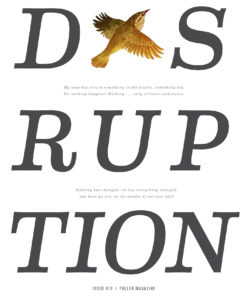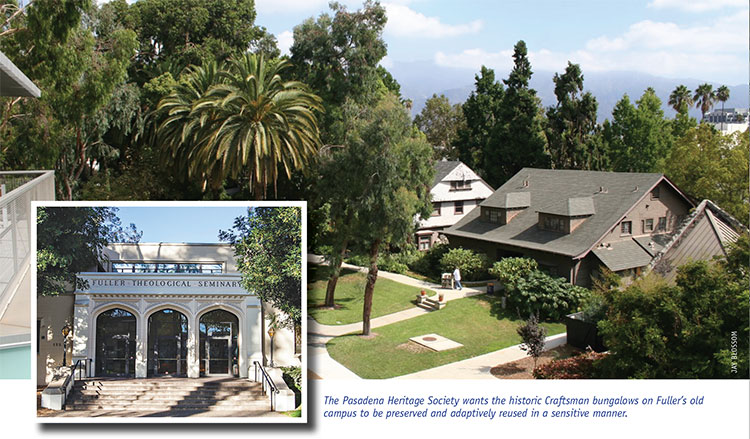
Credit: Jay Blossom
There's a small box at the edge of the sidewalk in front of an impressive Arts and Crafts building in the middle of Pasadena, California. It’s stacked full of Fuller magazines. Even from a distance you can see the word DISRUPTION on the cover in 200-point Century Bold, against a stark white background. A bird in upward flight replaces one of the letters.
It’s hard to imagine disruption in such a peaceful place, a grassy mall lined with ficus and palm trees that was created by Fuller Theological Seminary in 2004. The campus master plan emphasizes that “Fuller continues to be a welcoming thoroughfare for nearby businesses, tourists, and new Pasadena residents.”
 The disruption refers to the massive change about to take place at Fuller, which is one of the five largest accredited theological schools in North America. The seminary is leaving Pasadena, with its historic Spanish Revival houses and its high-end shops and restaurants, and moving 25 miles east to Pomona, a less affluent community working to overcome a longstanding reputation for crime and corruption.
The disruption refers to the massive change about to take place at Fuller, which is one of the five largest accredited theological schools in North America. The seminary is leaving Pasadena, with its historic Spanish Revival houses and its high-end shops and restaurants, and moving 25 miles east to Pomona, a less affluent community working to overcome a longstanding reputation for crime and corruption.
Disruption in this case is a double entendre — moving from one’s home of 70 years certainly will disrupt lives — but it also speaks to a facet of the seminary’s mission, which is to spur Christians to be disruptive agents in a world riven by disagreements about power, race, nationalism, and economics. In a 2018 address on the crisis of evangelicalism, president Mark Labberton threw down the gauntlet: There is “egregious collusion between evangelicals and worldly power,” he said. But Labberton’s conclusion was one of hope. “Jesus Christ gathers us here for real work. May it be a work of grace that moves us to repentance, leading to personal and systemic change. May it move us deeper into the life and heart of God.”
Practical rationale and challenges
While Fuller’s move may have spiritual implications, the precipitating factor has been more practical. Fuller has no urgent reason to move; the seminary has a healthy endowment and a head-count enrollment of 2,788 (with a full-time-equivalent enrollment of 1,257). Yet students, staff, and even faculty have found Pasadena’s high cost of living unsustainable.
This is not the first time that the seminary has considered moving. Labberton says that the board had its first conversation about moving about 50 years ago. The reason back then: the cost of living in Pasadena, especially for students. The idea of moving has arisen at least a couple of times since then.

This time, they moved on from brainstorming to planning. Early questions included: How much is the seminary property worth? Where could the seminary move?
Among Fullerites past and present, the move generated a variety of reactions, some of which were voiced in the recent “Disruption” issue of Fuller magazine. There was a mix of nostalgia for what Fuller meant in the lives of students, faculty, and staff. There was the fear of inexorably altering the school’s identity and purpose. But there was also a readiness to embrace change.
One of the biggest challenges was achieving consensus within a large 40-member board of trustees. The board includes six committees and four subcommittees of four to 12 members each. Three committees were created to work specifically with the move — a small executive committee, a real estate task force, and a design steering committee.
“The big arc was smooth, but it happened in stages,” Labberton says. “Within the board, there were people with deep historical and sentimental attachments to this place, have loved being here, and had no intrinsic desire to leave. But they were also aware that it was required to lay down assumptions about this particular environment and the expectations around it.”
The decision to move, which took 18 months, was conducted in steps. Questions were raised, answers sought, paths proposed. At each station on the journey, the board met, prayed, listened, deliberated, discussed, and then decided whether to move forward. Once the direction was set, the next set of questions was raised, and the process started again.
What matters almost more than board size and structure, says Labberton, “is the caliber of people and their true interest in the mission of the seminary. In that, we have been very fortunate.”
Discerning a new home
When they agreed to move, the board’s next step was to figure out where. Accreditation — Fuller has three accrediting bodies — meant that remaining in California was essential. They decided to stay in southern California out of respect for Fuller’s history in the Los Angeles area and its orientation to Latin America and the Pacific Rim. The decision to restrict the move to a 30-mile radius from Pasadena was to accommodate faculty and staff who were settled and had homes.
Within that radius in all directions, they looked at “every conceivable piece of land,” says Labberton. This included “existing buildings, intensely urban areas, varying suburban areas, and mixed-use developments.”
Pomona wasn’t an immediately obvious choice — nor was it serendipitous.
According to an article in the local newspaper, The Daily Bulletin, an elder at Pomona’s First Presbyterian Church, Tom Hsieh, “felt a prompting from God to reach out to Fuller Seminary about moving to Pomona.” Although he thought it was a “crazy idea,” he continued to send monthly property listings, and soon seminary representatives called to meet. From there, Hsieh connected them with Pomona civic leaders, including the mayor, for whom he was volunteer campaign manager.
After looking at possible Pomona sites, the board was amazed at the obvious renewal going on in the city, Labberton says. “It felt like we were invited into the Jeremiah 29 story” in which the prophet Jeremiah sends a letter to the exiled people of Israel, urging them to settle in and thrive. “It seemed clear evidence of God’s faithful work in a community that was being renewed.”

Fuller has already purchased property in Pomona (seen here) that includes parking lots and low-rise commercial structures. The land will be redeveloped as a brand-new campus.
Courtesy Fuller Theological Seminary
After a year and a half into the decision-making process, the Fuller team had winnowed their choices. It was a perfect May evening when the board met again to make a final decision on whether to move to Pomona. After discussion and prayer, Labberton says they all went outside and stood under the stars, in a circle, “breathing in the air, sounds, sights. We let everyone internalize the importance of this place. It was a time of thanksgiving to express thanks to God for what [Pasadena] meant to us. Then we had people name the things they felt called to lay down if we left, and the night closed in a beautiful and wonderful way.”
The meeting ended in a unanimous ballot.
Maintaining roots and embracing change
Pomona is 70 percent Hispanic, and is poorer and less developed than Pasadena, with fewer professional resources. Its multiethnicity brings the area to life, says Labberton. The arts are thriving and two universities already call it home — Cal Poly Pomona (with 25,000 students) and Western University of Health Sciences (with more than 3,500 students).
Fuller will be “entering the city listening to many constituents, including churches and religious groups,” says Labberton. “We want to leave Pasadena well, and we want to arrive in Pomona learning how we can be good neighbors to Pomona and beyond.”
As different as the two cities are today, Pomona isn’t such a radical departure from Fuller’s starting point in 1947, when 39 graduate students attended classes in the Sunday school rooms of the Lake Avenue Congregational Church, “sitting in child-sized chairs as they learned from a charter faculty of theological giants,” according to the Fuller website.
Fuller’s vision always was of academic excellence, solidly evangelical and culturally attuned. Or, as Labberton puts it, to be “open, porous, and fully engaged with the neighborhood.” He says that the vision continues. “We want to be an institution that cares about where we are and engages the city around us. It matters that we are going to be in a fertile place, although with different soil.”
Engagement isn’t a one-way street, so Fuller’s new community will likely “reset” the school’s culture. In Pasadena, the spread-out nature of the campus led to silos, Labberton says. “When administration resides in different buildings, partnership and collaboration can be more complicated.” In Pomona, the entire campus will occupy fewer than five acres, not including student and guest housing, making it easier to foster a collegial atmosphere.
When asked whether this move will affect the age or ethnicity of the student body, Labberton says that they have been changing for a while. As in other seminaries, student age rises or falls with unemployment rates — higher unemployment tends to bring in younger students and vice versa. Fuller already enrolls students from 90 countries, but given its new, more multicultural neighborhood, it’s possible that the seminary will be able to serve the Latino community (which is dominant in Pomona) while remaining committed to African American, Asian, and Asian-American communities, all of which are present in smaller numbers.
With Pomona’s lower housing costs, plus support through appropriate scholarships, the seminary hopes to foster a “rigorous residential program,” Labberton says, at the same time recognizing that online studies will continue to expand.
“We’re putting together all the components for strong residential, master’s, and Ph.D. programs, and for online degrees as well as online resources, such as Fuller’s leadership platform, and people who are generally looking for serious philosophical and theological resources,” says Labberton.
The new property, at the corner of Garey and Holt Avenues, is part of an established neighborhood and will be urban infill rather than a blank slate. But the smaller footprint allows for greater cohesion.
Although the campus is expected to be completed in three years, nothing has yet been revealed about its eventual design. Labberton says he can divulge no more than a promise that “it will visually and architecturally continue Fuller’s ethos, which is open, engaged, beautiful, transcendent, incarnational,” and that it will reinforce a distinct identity for the seminary.
Meanwhile, back in Pasadena
Once it became public knowledge that Fuller was moving, the Pasadena Heritage Society quickly moved to ensure that the various buildings, especially the seminary’s historic Craftsman homes, would be preserved and adaptively reused in a sensitive manner. The group calls the campus “a critically important central Pasadena place that requires careful planning.
Fuller is considering offers from a variety of buyers, according to Pasadena Now magazine. In addition to asking that sidewalks, streets, and open spaces remain accessible to the public, the heritage society has recommended that the central campus area be retained as an “urban oasis.” Of particular note is the seminary’s prayer garden, which the heritage society says has become “a valued open space for campus residents, nearby residents, and the community.”